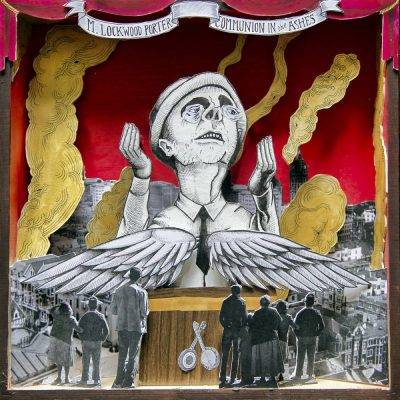M. Lockwood Porter Communion in the Ashes
M. Lockwood Porter
Communion in the Ashes
Black Mesa
Communion in the Ashes is flat-out rock n’ roll, a rallying cry, a series of anthemic songs by M. Lockwood Porter and his five-piece band designed to build hope amongst the surrounding doom. Yes, this about community and moving forward rather than wallowing in despair. It’s one of those roll-down-your-windows and let-the-wind-blow-back-your-hair records, full of hooks and jangling guitars. No doubt he owes both to Dylan and Springsteen, but this is not a new stance for him. Social and political issues were the focus of his 2016 How to Dream Again.
Lockwood, an Okie by birth, launched his songwriting career in the San Francisco Bay area, the nation’s highest cost of living area. Having taught in an inner city school, he witnessed first hand the class divide between the boom and those reveling in the tech boom. Eventually he felt that working-class folks and artists weren’t welcome there anymore. After writing this album, he returned to Oklahoma with the goal of contributing to a growing artistic community and to, in his own way, try to affect social change.
As the album moves away from the opening title track, the music broadens into a meshing of indie rock, folk, and Americana. The album was written alone on an acoustic guitar, so it inevitably has some singer-songwriter flavor and ballads, but it retains an energetic pulse throughout. At times, it’s absolutely thrilling. His messages are clear – “When the bridges are all burned, let’s congregate the masses, let’s hold a new communion in the ashes.” On the piano-driven Southern Baptist-influenced “I Will Do No More A-Prayin’”and “Blessed to be Alive” there’s a calmness of a Sunday morning but most it is a sweat-soaked Saturday night throwdown. “The Dream Is Dead” exemplifies this sound of furiously strummed power chords, pounding upright piano and the 80s- inspired synthesizers, with urgent lead and enthusiastic backing harmonies. Like The Boss in The Rising Lockwood Porter is about mobilizing and rebuilding.
Although Lockwood Porter wrote the album alone, the recording process was collaborative, appropriately so in view the main theme of community. All five band members contributed to arrangements and drummer Peter Labberton also engineered and mixed. They did not rehearse, instead opting to rely on quick decisions and instincts while laying down the tunes. The one exception was one of the disc’s stronger songs, “Get Back to the Wild” where a two-bar drum and piano loop are instilled into a song that examines the gap between human nature and human society.
Guitarist Jeremy Lyon is credited with bringing a wider palette of guitar tones to this one than the previous Lockwood albums. Lockwood Porter says, “This is also the first I’ve recorded with synthesizers. I had given the band the vague direction that I wanted us to imagine ourselves as a ‘dystopian gospel band’ before we started recording, and my keyboardist Jeff Hashfield found a sound on his Prophet synthesizer that we ended up dubbing the ‘Blade Runner church organ.’ We ended up using it on nearly every song.”
This imagery of a ‘dystopian gospel band’ not only runs through the lyrics but on the cover art where a crazed demagogue or preacher is addressing a crowd from the foreground of a burning city. As you listen to the engaging, epic closer “Nowhere Left to Run,” featuring Lyon’s somewhat bluesy lead guitar, the music just gradually fades, as if giving the listener the chance to reflect on the preceding messages. Yes, it’s political but thankfully it doesn’t have that “in-your-face” effect like that of punk-rockers. The rock n’ roll pulse makes it eminently listenable.
Discover more from Making A Scene!
Subscribe to get the latest posts sent to your email.















































